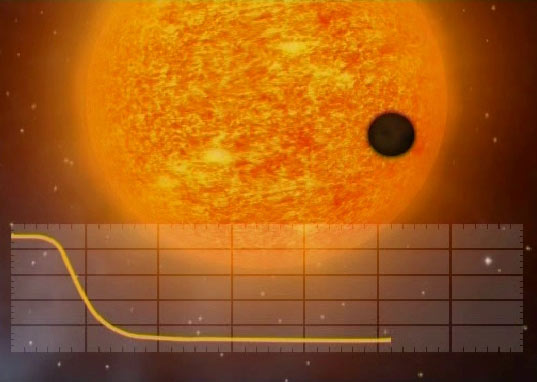Scorched Earth: Small, Hot Planet Found

Editor's Note: This article was updated at 2:55 p.m. ET to reflect additional perspective from another astronomer, questioning the claim that this planet is the smallest exoplanet known.
What may bethe smallest extrasolar planet, measuring less than twice the size of Earth,has been discovered orbiting a sun-like star.
The worldis far hotter than ours, however. And controversy over the size claim has heated up, too.
Astronomersused the COROT space telescope (a mission led by the French Space Agency, andalso involving the European Space Agency and others) to detect the newplanet as it transited its parent star, dimming the light from the star asit passed in front of it. The host star is located 457 light-years from Earth,where onelight-year is the distance light will travel in a year, or about 6 trillionmiles (10 trillion kilometers).
"Forthe first time, we have unambiguously detected a planet that is 'rocky' in thesame sense as our own Earth," said Malcolm Fridlund, ESA's COROT ProjectScientist. "We now have to understand this object further to put it intocontext, and continue our search for smaller, more Earth-likeobjects with COROT."
He added,"This discovery is a very important step on the road to understanding theformation and evolution of our planet."
SaraSeager, an astrophysicist at MIT who was not involved in the discovery said,"My first thought is that it's extremely exciting because we've beenwaiting to find a planet that we can really call rocky. I would just cautionthat more information, more data, is needed."
Get the Space.com Newsletter
Breaking space news, the latest updates on rocket launches, skywatching events and more!
Forinstance, the discovery has yet to be published in a peer-reviewed journal, andnot much information about the planet has been released by COROT scientists.Seager says in order to confirm an exoplanet is rocky, scientists need to naildown its mass and radius (or the combination of size and density, or mass and density).
"It lookslike the mass is not well-determined and so that's why they're saying they'renot sure what the density is," Seager told SPACE.com. "Theythink it is terrestrial-like. It might have water ice, or it might have rocks,but it's certainly not a gas giant."
COROTscientists estimate the planet ranges from 5.7 to 11 Earth masses.
Hotdiscovery
One bigdifference in the newfound planet compared to Earth: COROT-Exo-7b is locatedvery close to its star, orbiting once every 20 hours. Its temperature is sohigh, ranging from 1,832 to 2,732 degrees Fahrenheit (1,000 to 1,500 degreesCelsius) that the researchers say the exoplanet could be covered in lava orwater vapor.
The densityof the planet is still under investigation, though scientists say it may be rockylike Earth and covered in liquid lava. COROT-Exo-7b may also belong to aclass of planets that are thought to be made up of water and rock in almostequal amounts. Given the high temperatures measured, the planet would likely bea very hot and humid place.
"Findingsuch a small planet was not a complete surprise," said Daniel Rouan,researcher at the Observatoire de Paris Lesia, who coordinates the project withAlain L?ger, from Institut d?Astrophysique Spatiale. "COROT-Exo-7b belongsto a class of objects whose existence had been predicted for some time."
Smalland odd
Very few ofthe morethan 300 exoplanets found so far have a mass comparable to that of Earthand the other terrestrial planets ? Venus, Mars and Mercury. That's becauseterrestrial planets are extremely difficult to detect.
Of theEarth-like planets detected, this is the first one spotted using the so-calledtransit method, which can yield both the planet's mass and radius. Othermethods just reveal the planet's mass, Seager said.
The newfound planet's size status is also questioned. When astronomers study planets, they're interested in both mass and diameter.
"Theclaim that it is the 'smallest exoplanet' found to date is not correct," saidplanet-formation theorist Alan Boss of the Carnegie Institution of Washington."It is the smallest mass exoplanet found to date that transits, but otherhot super-Earths have been found that do not transit but have lower masses."Boss was not involved in the current discovery.
Forinstance, he adds Gliese 876 d has "a minimum mass of 5.9 Earth masses anda best estimate for the true mass of 7.5 Earth masses."
Most of themethods used so far are indirect and sensitive to the mass of the planet, whichis why bigger worlds are easier to detect. COROT can directly measure the sizeof a planet's surface, which is an advantage to astronomers. In addition,because the probe is in space, it has longer periods of uninterruptedobservation than from the ground.
Theinternal structure of COROT-Exo-7b particularly puzzles scientists, as they areunsure whether it is an "ocean planet," a kind of planet whoseexistence has never been proved so far. In theory, such planets would initiallybe covered partially in ice, and they would later drift toward their star, withthe ice melting to cover it in liquid.
- Video: Planet Hunter
- Top 10 Most Intriguing Extrasolar Planets
- Study: Earth-like Planets Common
Join our Space Forums to keep talking space on the latest missions, night sky and more! And if you have a news tip, correction or comment, let us know at: community@space.com.

Space.com is the premier source of space exploration, innovation and astronomy news, chronicling (and celebrating) humanity's ongoing expansion across the final frontier. Originally founded in 1999, Space.com is, and always has been, the passion of writers and editors who are space fans and also trained journalists. Our current news team consists of Editor-in-Chief Tariq Malik; Editor Hanneke Weitering, Senior Space Writer Mike Wall; Senior Writer Meghan Bartels; Senior Writer Chelsea Gohd, Senior Writer Tereza Pultarova and Staff Writer Alexander Cox, focusing on e-commerce. Senior Producer Steve Spaleta oversees our space videos, with Diana Whitcroft as our Social Media Editor.









